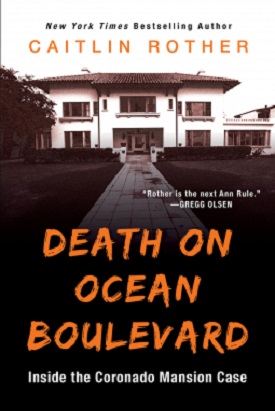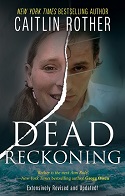 Synopsis:
Synopsis:
Bestselling author Caitlin Rother explores the mysterious death of 32-year-old Rebecca Zahau. Her body was found hanging from a second-story balcony at the historic Spreckels Mansion, a lavish beachfront property in Coronado, California, owned by her boyfriend, pharmaceutical tycoon and multimillionaire Jonah Shacknai. She was naked and gagged, with her ankles tied and hands bound behind her. On the door to her bedroom investigators found a hand-written message:
SHE SAVED HIM
CAN YOU SAVE HER
Was the scrawled message a suicide note or a killer’s taunt?
The call came on the morning of July 13, 2011: “I got a girl, hung herself in the guest house.” Jonah’s brother, Adam, claimed to have discovered Rebecca’s body.
Rebecca’s death came two days after Jonah’s six-year-old son, Max, took a devastating fall while in Rebecca’s care. Authorities ruled Rebecca’s death a suicide resulting from her guilt. But who would stage either a suicide or a murder in such a bizarre, elaborate way?
Rother reveals that there’s more to the story . . .
Death on Ocean Boulevard includes stunning new details about the complicated case. Rother examines the civil trial that concluded with a jury finding Adam Shacknai liable for Rebecca’s death, and the San Diego County Sheriff’s Department bombshell decision to reconfirm its original finding that Rebecca took her own life.
Compelling and troubling, this controversial real-life mystery is a classic American tragedy about which numerous questions abound.
Review:

The San Diego County Sheriff’s Department may have quickly deemed Rebecca Zahau’s death a suicide, but to this day, the circumstances surrounding the fatal injury sustained by little Max Shacknai and Rebecca’s demise just two days later remain a mystery. If the Sheriff’s Department was motivated to rush to a specific conclusion, the reason(s) have not yet been revealed. But award-winning author Caitlin Rother has spent years searching for answers.
Death on Ocean Boulevard may well be Caitlin Rother’s best book yet. She again presents a thoroughly researched, thoughtful examination of an actual case, the unsolved Spreckels Mansion deaths, but this time with a personal twist that makes her narrative even more compelling and compassionate. Rother relates that her curiosity was aroused as soon as she heard about the case, but “the more I learned, the more haunted I became.” To her memoir, Secrets, Lies, and Shoelaces: A Story of Hardship and Healing, Rother brings the same unsparing honesty and journalistic integrity that make her meticulously researched true-crime novels intriguingly readable. Therein, she relates the harrowing story of her marriage to Rich Rose, who threatened to commit suicide several times before following through in April 1999. He took his life by hanging in a hotel room in San Quintin, Mexico, where he left his driver’s license and bank card on display so that he could be identified and notification made to Rother. She had no way of knowing then that twelve years later the death of a local thirty-two-year-old woman by hanging would become “so all-encompassing that every time I would try to walk away it would pull me back in.” Her exploration of the case would not only span years, but also prove enormously difficult, exasperating, and a “compulsion — obsession even — to solve this mystery.”
In painstaking detail, Rother tells the story of Rebecca’s familial history, as well as her bizarre relationships with three men. She had an on-again, off-again relationship with her allegedly abusive ex-husband, Neil Nalepa, who, even at the time of her death, had “exceedingly insistent contact” with her, texting daily to declare that he would do anything to make their marriage work. Additionally, Rebecca was involved with Michael Berger, a martial arts instructor, from whom she initially hid the fact that she was still married to Neil. In fact, when she began dating Michael, she was still living with Neil. Michael urged her to move forward with the divorce she said she wanted when she related that her marriage to Neil had been arranged by her father and Neil was an abusive drug user. At one point, she disappeared but contacted Michael claiming that someone “took me.” Insisting she didn’t know where she was because her purported abductors put “something over my eyes,” she told Michael she was only able to make a call because her kidnappers permitted her to use the bathroom. She then hung up, but called him several more times. He filed a police report. In one call, she seemed to recite a drafted statement informing Michael he was “not to see me anymore, ever again.” Michael heard men’s voices in the background, and one of them threatened, “I know where you live.” When Rebecca showed up at Michael’s house again, he insisted they go to the police. In reality, Rebecca had again reconciled with Neil and, meeting alone with detectives, confessed she had failed to inform Michael of that fact. A couple of days later, she disappeared yet again, texting Michael that she was in Portland, Oregon, to “clear my head,” but professing love. In truth, Rebecca had by then made her way to her sister’s home in Missouri after living with Neil in Portland where things “went sideways once again.” After further stints with Neil in Pennsylvania and Colorado, Rebecca went to Arizona in December 2007.
Rebecca told her sisters that every time she tried to break away from Neil, he begged for another chance. He supposedly promised repeatedly to go to counseling, and that he would refrain from yelling and threatening Rebecca, who loaned him money and returned to the marriage time after time. Rebecca purchased a home in Arizona and got a job as an ophthalmic technician. It was there, in October 2009, that she met Jonah Shacknai, a twice-divorced father of three children, and then-CEO and founder of Medicis Pharmaceutical Corporation, headquartered in Phoenix.
Jonah initially purchased the historic Spreckels Mansion to serve as a summer home, but it became his full-time residence. Jonah was able to supply Rebecca with the lifestyle she had always wanted and she called him her “warrior.” Although they came from very different backgrounds, and Jonah was significantly older than Rebecca, they were both interested in health and fitness, and Rebecca was willing to be a caregiver. Unfortunately, after Rebecca moved into the house in March 2010, without Jonah’s knowledge because he was away visiting his parents, Rebecca’s relationships with Jonah’s two oldest children and his second wife, Dina, were fraught with conflict. But she and Max loved each other, even though Dina was concerned about having Rebecca caring for her young son when he spent time at his father’s house. To Dina, “something felt amiss,” but she was initially unable to ascertain any information about Rebecca’s past. Dina’s sister, Nina, felt Rebecca was “never what she seemed. She was presenting herself in a way of what Jonah would want.”
On July 11, 2011, Ariel, Rebecca’s thirteen-year-old sister had just arrived for a visit. When she heard Rebecca scream her name, she looked down to the foyer of the mansion from the second floor landing. She saw Rebecca cradling Max’s head in her lap as he lay in an alcove near the bottom of the stairs. Around him was glass, the broken chandelier lay nearby, and Rebecca’s dog was pacing around. Ariel called 911 and responders reported that Max was lying on his back with a razor scooter across his right shin with a soccer ball nearby. Rebecca claimed she had given Max mouth-to-mouth resuscitation, but could not recall if she had found him on his back or flipped him over. The chandelier’s cord had been “severed” and Rebecca was distraught, relating that she was in the downstairs bathroom under the stairwell when she heard a crash, ran out, and found Max, who had gone upstairs to his bedroom twenty minutes earlier. She also claimed Max uttered several unintelligible words, but then he lost consciousness after uttering her dog’s name, Ocean. When Max arrived at the emergency room, he was resuscitated but not before he was deprived of oxygen for twenty-five to thirty minutes. Tragically, Max was later declared brain-dead and removed from life support.
And just two days later, tragedy befell Jonah again when his brother, Adam, who had come to San Diego to support Jonah when Max was injured, placed another 911 call from the mansion, stating that he found Rebecca’s body.
Rother employs her signature straight-forward style to relate the details of a case that continues to fascinate and confound those who have followed it. She lays out the various ways in which the investigation conducted by the San Diego County Sheriff’s Department was rushed, flawed, and inconclusive, even though officials quickly ruled that Rebecca took her own life. That Rebecca could have logistically killed herself in the manner the evidence at the scene suggested is not just implausible, but virtually impossible, according to some experts. Moreover, the forensic evidence does not bear out that Rebecca managed to bind her own hands and feet, place a t-shirt around her neck and into her mouth as a gag, and tie rope around her neck before hurling herself off the second-floor balcony. Notably, she showed no signs of being distressed or feeling guilty about Max’s injuries to the point that she might be contemplating suicide. It appeared there was no blame hurled at her by Jonah, even though he pressed her for answers, and she did not express responsibility for Max’s fall, contending that she found him in the foyer and did not know what happened. Experts on the topic opined that women do not take their own lives in the way Rebecca allegedly did — and certainly not nude — even though, in rare cases, individuals do take steps to ensure that, at the last moment, they will be unable to change their minds and save themselves. Rebecca’s family has steadfastly maintained that she would never have taken her own life. And most certainly not in such a spectacular manner that would bring shame to herself or the family. And what of the cryptic message scrawled on the door? If Rebecca wrote it herself, what did it mean?
Rebecca’s injuries were inconsistent with suicide. An autopsy showed that she had four subgaleal hemorrhages on her scalp, and even though she allegedly fell nine feet from the balcony, her spinal cord and cervical vertebrae were intact. Although she had abrasions and contusions on her body, they were not on her arms, face, and the front of her body where they would logically appear as a result of contact with the large plants under the balcony. Perhaps most telling, if she had been actually been hanging by the neck for several hours before being discovered by Adam, blood should have pooled in her feet and lower extremities, not across her back and in other areas of her body where signs of lividity were observed. The evidence suggested that she had, in fact, been lying on her back, not hanging upside down.
In clear, readily understandable prose, Rother highlights the disparities between the Sheriff’s Department’s conclusions and the evidence collected at the scene, as well as the various steps that investigators stepped, clues they ignored (willfully, perhaps), and evidence they failed to collect and analyze. Rother attempted unsuccessfully to uncover a connection between Jonah — a powerful, wealthy resident of a community known as a safe environment where people did not, even in 2011, lock their doors — and Sheriff’s Department officials that would provide the impetus to rush to a conclusion and close the case.
Likewise, Rother explains that Max’s injuries were not consistent with conjecture about the manner in which he fell. In the opinion of Max’s physician, it would have been impossible for him to speak when Rebecca discovered him lying on the floor. And if she had truly performed mouth-to-mouth resuscitation Max might have had a better outcome. Did he fall over the railing while riding his Razor scooter on the second floor, grabbing for the chandelier as he fell? Or did he suffer from an underlying medical abnormality that caused him to suffer sudden cardiac arrest before falling to the floor below? Or was he murdered?
Rebecca’s family filed a wrongful death suit and Rother attended the contentious jury trial. Her play-by-play of the legal machinations, including the performances of the parties’ attorneys, is absorbing and entertaining. She relates her first-hand observations and impressions, as well as the shocking verdict delivered by the jury.
If Rebecca did not kill herself, but was, instead, murdered, who is responsible for her death? Rother ponders the motives that various potential subjects might have harbored for wanting both Rebecca and Max dead. Jonah wondered if a disgruntled former employee could have hurt him by harming his child or girlfriend. Dina never enjoyed a harmonious relationship with Rebecca, even banning her from Max’s hospital room after he was injured, and her sister, Nina, was closely aligned with her. Could a grieving mother or aunt have sought retribution? Dina, at least, was confirmed to have been at Max’s bedside when Rebecca died, and Jonah’s whereabouts were also confirmed. A neighbor claimed to have heard a woman screaming for help, raising questions about whether Adam killed Rebecca after she rebuffed his advances.
At one point, a private investigator retained by Dina’s insurance company even consulted medium Jackie Bensinger. Performing an energy reading, she claimed the energy emanating from Rebecca’s bed was “electrified” and she could sense the placement of the rope that had been placed around it. The opposite end of that rope was tied around Rebecca’s neck, and Bensinger also reported that she channeled Rebecca who had been “lying on the bed. I saw her look up” and a man she knew was hurting her, as Rebecca asked, “Why are you doing this to me?” Bensinger felt the sensation of being choked and was convinced that Rebecca died in that manner. She also insisted that she channeled Max, who showed her that “he was taken down, that he was murdered” when someone behind him threw him over the railing. She believed two men who involved who had a business connection to Jonah, and the murders of Rebecca and Max were revenge killings.
Rother explores the various conspiracy theories that have abounded and continue to be floated by interested observers, as post-trial legal proceedings continue winding through the courts. She notes that her investigation caused her to reject many of those theories outright because they were unsupported by forensic, medical or mechanical evidence, or debunked by uncontroversial clues. Despite her dedication to the case and quest for answers, Rother concedes that, at this point, no one is able to state for certain what happened to Rebecca or Max. Rebecca’s history of lies, deceit, and instability certainly call into question whether someone from her past caught up with her in Coronado and murdered her. But Rother also knows from personal experience, as well as professional expertise garnered through her years of investigative journalism, that family members frequently are unaware that a loved one was contemplating suicide . . . until it is too late. Even so, Dina and Rebecca’s family remain convinced that both Max and Rebecca were murdered.
Rother’s tautly-constructed, enthralling telling of their story is both fascinating and haunting, and a must-read for true crime fans. A less-skilled author could easily have imprinted his or her personal experiences upon the writing. But Rother deftly strikes a perfect balance between compassionately exploring Rebecca’s life and what transpired. She considers the complex emotions of all involved, and objectively examines the available evidence through the lens of a woman who survived a dysfunctional marriage and suicide of an ex-spouse. Because of her background, she credibly offers insight and perspective while inspiring readers to take all of the information presented into account before drawing their own conclusions.
For Rother’s part, she concludes that, based upon her years-long, intense exploration of the case, “Rebecca’s death was staged to look like something it wasn’t.” But she concedes that she doesn’t “know what happened. I can see both sides of it, and I have never been convinced either way. There are big holes in the investigation that will never be filled.”
But what really happened may forever remain a mystery that little Max and Rebecca took with them to their respective graves. Rother observes, “This is a tragedy, no matter how you look at it.”



















Comments are closed.